Components of Creating a Stronghold
[“Behind the Wall” is a regular content series that explores various aspects of Rainbow Six Siege, based on the first demo shown. All design and content presented in these articles is a work in progress, and subject to change between now and the final release of the game.]
You know they’re coming. You’re not sure when, but hell could break loose at any moment. The worst part is that it’s not only a matter of when, but where. The wall or ceiling could blow apart at any moment, followed by a flashbang and a hail of gunfire. Or maybe the windows will be quickly kicked out as operators storm through them on rappel ropes. Your enemy is silent, lethal and well-equipped, but you’ve got some tools of your own to thwart their plans.
Each tool has a unique function for a specific purpose, but over time you’ll learn ways to combine them together for maximum effectiveness
As a defender in Rainbow Six Siege, what’s behind the wall is you. Well, you and the fortifications you’ve set up to blockade against the attack. Each tool has a unique function for a specific purpose, but over time you’ll learn ways to combine them together for maximum effectiveness.
The stronghold is your deathtrap to lay, and we want you to make choices on what direction you’re going to push the attackers to take. Where attackers seek to breach and neutralize, the core actions of defenders will lie in barricading the environment, trapping the attackers and keeping surveillance on their movements. We designed the initial toolset around these actions, so let’s take a look at what they are:
Barricading the Environment
Even since medieval times, resisting a siege situation begins by building and barricading a stronghold. Back in the day this meant building a castle and restricting enemies to specific approaches for breaching. This occurs on a micro scale in the modern day, where attacks and movements are quicker, deadlier and more precise. In Rainbow Six Siege this starts with door and window barricades. These contraptions consist of wood planks held together by rope net that neatly fits together when unfurled. You’ll lay them down over doors and window, not really as a shield (these are just wood planks, after all), but to obscure lines of sight and create one extra hurdle in the insertion process. Placing them in windows on the façade of a building means that attackers won’t be able to see your team running around inside unless they use up ammo shooting holes through it, or placing a breach charge.
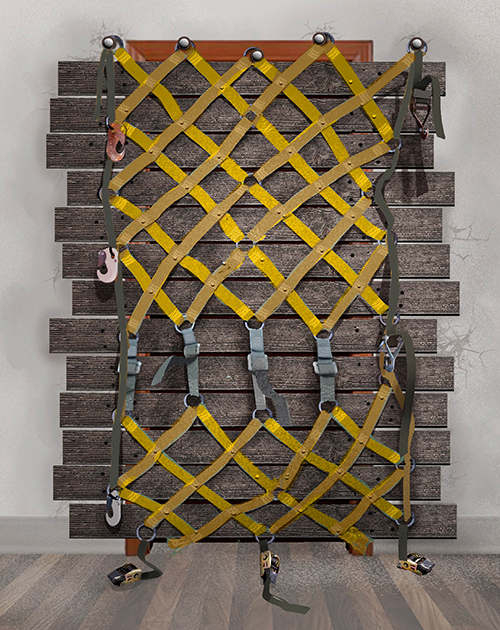
Door and window barricades roll down neatly to obscure lines of sight
These will be the bread and butter of your fortification process as each defender will have an unlimited number available to them, and you can even place them once the action phase starts. However, laying one down will make you vulnerable as it takes about 2.5 seconds to set up (or take down if you need to get through). With only one life to live and attackers showing up at any moment, it’s a hard decision to make if you want to push it. You can interrupt the placement, but in a game where a split second can make a difference, it might not be in time.
Reinforced walls are the next step up in the fortification process and unlike barricades, are limited in number. What they lack in availability they more than make up for in strength. These heavy reinforcements are indestructible, can be placed on walls and floors, and cannot be breached. They’re best used in rooms around the objective where you absolutely cannot afford to have the attackers breach through. Each defender only has two of them, so you’ll need to make hard choices about where they’re placed in order to create effective chokepoints. We wanted the design and animation to feel natural and comfortable, and you’ll hold down the placement button while the animation runs. If you let go before it’s finished setting up it’ll return to your inventory, and sometimes this comes in handy if you need to react quickly to an unexpected breach.
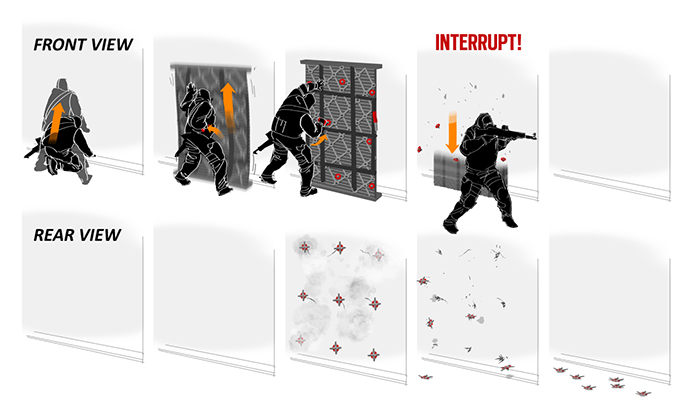
Wall barricades eject pistons that latch into the wall, but can be interrupted during setup
The contraption itself is something of our own creation and we spent a lot of time thinking about how to do this in a functional but realistic way. We arrived at the idea of having interlocking metal components that are spring loaded at the base. You activate the wall and once it’s reached full length, pistons attached to it will shoot through the wall and expand, locking it in place. At this point the wall cannot be removed, by you or anyone else. Think about these carefully to set up permanent chokepoints because attackers will have no choice but to re-route around them.
Some defenders will take a deployable shield with them. Handmade out of slabs of Kevlar, the deployable shield has a very slight “V” shape that allows a player to crouch behind it with some angled cover. There’s no contextual lean, so you are free to peer around it however you like to get the best angle for the shot. Technically you can even carry it around in front of you like a less effective version of the ballistic shield, but that’s not necessarily recommended because your head and feet will still be exposed, and you cannot carry a firearm.
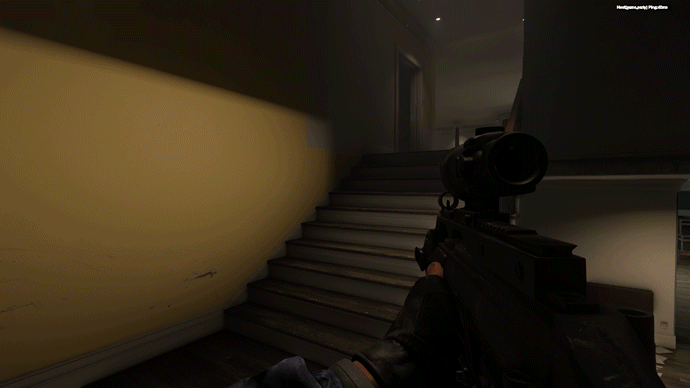
Deployable shields may not make the best cover while mobile
They’re interesting tools because beyond the defensive face value of the barricade, they can also act as traps. As an attacker, when you see a deployable shield in a room or hallway, you immediately think that someone must be hiding behind it. Defenders can use this to their advantage by actually positioning themselves in a different spot, or even placing a nitro cell in the shield wedge to knock out an attacker when they come up to inspect.
Act intelligently and you can trick the attackers, setting a deadly trap as they come too close and BAM you take out several with the press of a button
Trapping the Attackers
Attackers aren’t the only ones utilizing destruction as a tool. Select defenders will carry a nitro cell into conflict. We call them nitro cells because simply put, they’re C4 explosives connected to a cell phone. You can’t throw them too far because they’re heavy, and they can’t stick to your teammates or other players (these aren’t plasma grenades). But, like many other tools in the game, their placement isn’t contextual – you can set them up on any surface you choose. Placement is critical because attackers will sense that a nitro cell is nearby when they start getting radio static from the cell signal, and they can shoot it out when they see the red light blinking. However, act intelligently and you can trick the attackers, setting a deadly trap as they come too close and BAM you take out several with the press of a button.
Nitro cells have some unique properties that differ from other destructive devices in the game. For one, unlike the breach charge, they aren’t controlled blasts. They’re more chaotic and will not blow out clean holes in walls. You can also have some fun with them in creative ways, like opening a small hole in a wall with gunfire and tossing the nitro cell through it to land on another wall.
Tools don’t always have to be fancy contraptions to be effective and good old-fashioned barbed wire is a great example of that. Every defender starts with two coils that they can toss down on any walkable surface. The coils will spring out to their maximum size, but they’re also reactive so they’ll bunch up in a hallway or corridor if space is limited. Walking through barbed wire will not only slow down an attacker, but will deal a small amount of damage and create noise.

Design doc extract explaining some properties of barbed wire placement
The beauty of tossing down some barbed wire is that sometimes all you need is for the attacker to notice the threat and re-direct around it. Defenders will often use barbed wire at common exit points once attackers have made contact with the hostage. Seeing that coil on the ground will force a difficult decision. Attackers have the ability to melee the coil down into something more manageable, or remove part of it with a grenade, but that comes at the expense of time, vulnerability or resources.
Surveillance of Enemy Movement
Last but not least, defenders can make the best use of their stronghold design by keeping tabs on the enemy’s movements. While attackers come equipped with manually controlled drones, defenders will use elements in their environment to keep track of attacker movements. They’ll have access to surveillance cameras that are strategically placed around the map to keep tabs on intruders. The cameras have limited movement and can only be controlled by one defender at a time. This doesn’t mean that defenders have an all-seeing eye, there are a limited number of cameras on each map and smart attackers will use a bullet or two to take them out while commencing the siege.
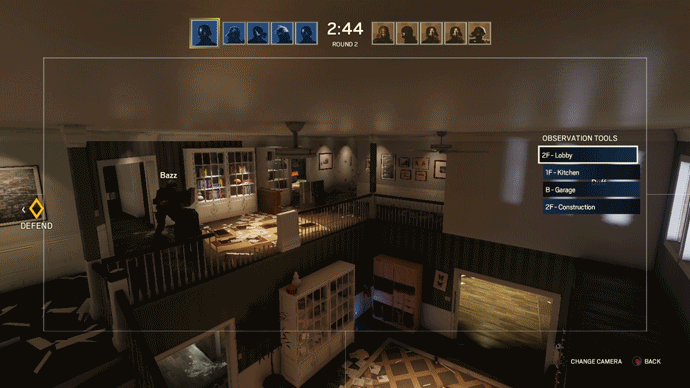
Strategically placed surveillance cameras provide another view of the action
Beyond their functional purpose, we wanted the cameras to contribute to the fantasy of being holed up in a stronghold. The view through the cameras evokes a realistic CCTV view, and there’s something ominous about following an attacker’s movements with your camera, unaware that they’re being watched.
We talk a lot about having these moldable environments and indeed, that’s what we’re trying to achieve with the maps in Rainbow Six Siege. Because everything is so destructible, both attackers and defenders will have to use their tools to shape the map to their liking. Beyond their individual use, full potential of these tools will be realized in the combinations you create. It’s your sandbox to play in and we can’t wait to see what you do with it. Look for next month’s theme on the Rainbow Six YouTube channel, and until then share your feedback with us:
- What combinations of tools do you imagine using on defense?
- What other tools would you like defenders to have?
- What do you think is the cornerstone of a rock solid defense?
[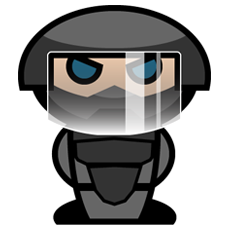](https://www.reddit.com/r/rainbow6)

Chase “Electr1cPanda” Straight - Community Developer, Ubisoft Montreal
Chase is a goofy American ex-pat living in Canada who loves music, DJing, blogging, and obviously gaming for hours. No discrimination here, Chase loves consoles as much as playing on his homebuilt gaming rig. Say hi and send cat pics (bonus points if they're wearing R6 gear) on Twitter at @R6ComDevs.

Genevieve "Livinpink" Forget - Community Developer, Ubisoft Montreal
Gen goes by the handle Livinpink in the gaming industry. She is known for her involvement in multiple competitive gaming communities through her work as eSports media and personality. She participates in weekly livestreamed Dungeons and Dragons sessions. She also tweets from @R6ComDevs.



